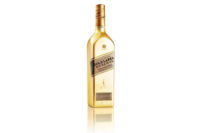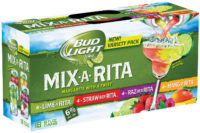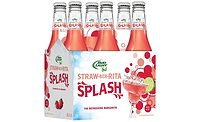FMBs and RTD cocktails offer convenience for at-home enjoyment
Flavors, portability benefit FMBs, RTD cocktails

Smirnoff Ice Black is aimed at men between the ages of 21 and 29 and packaged in sleek black cans. (Image courtesy of Diageo North America)





With many consumers lacking the tools or know-how to reproduce some of their favorite on-premise cocktails, beverage manufacturers have found a way to deliver that same enjoyment to consumers in their own homes.
| Jump to: |
Jennifer Zegler, beverage analyst with Chicago-based Mintel, notes that flavored malt beverage (FMB) brands, also referred to as progressive adult beverages (PABs), are modeling products after classic cocktails. “The classic cocktail-inspired flavors also tap into consumers’ desire for convenience, which [allows them] to enjoy the flavor of a cocktail without having to be a mixologist,” she says.
Similarly, the ready-to-drink (RTD) cocktail segment, sometimes referred to as prepared cocktails, also has found favor for its convenience factor, she adds.
That consumer appeal is reflected in the category’s sales numbers. According to Chicago-based Information Resources Inc. (IRI), PAB sales increased 23 percent totaling more than $1.3 billion for the 52 weeks ending May 19 in U.S. supermarkets, drug stores, gas and convenience stores, mass market retailers, military commissaries, and select dollar and club retail chains. Posting high single-digit growth, prepared cocktail sales increased 9.5 percent for more than $363 million in sales, the market research firm adds.
Keeping up with innovation
In line with Mintel's Zegler’s point about classic cocktails, Geloso Beverage Group, Rochester, N.Y., released its Clubtails brand last year in four varieties: Sex on the Beach, Screwdriver, Bahama Mama and Long Island Iced Tea.
The FMB segment also has seen large players embrace the cocktail trend. St. Louis-based Anheuser-Busch, a wholly owned subsidiary of Anheuser-Busch InBev, introduced Bud Light Lime ‘Lime-A-Rita’ last year. Following the product's success, the company launched ‘Straw-Ber-Rita’ earlier this year.
Another noticeable trend taking place in the FMB sub-category has been brands packaged in cans with a more masculine appeal, Zegler explains. Last year, Norwalk, Conn.-based Diageo North America, a division of Diageo, released Smirnoff Ice Black aimed at men between the ages of 21 and 29.
Noting the improvement of ingredients, natural direction and hybrid products, Spiros Malandrakis, senior alcoholic drinks analyst for Chicago-based Euromonitor International, says the frozen cocktail trend also is gaining steam in the RTD alcohol segment as companies like Diageo have released their own offerings. “These are targeting younger demographics, but they have a more sophisticated appeal,” he says.
Releasing its own line of single-serve frozen drinks, Chicago-based Mike’s Hard Lemonade Co. recently launched Mike’s Hard Lemonade Frozen, Mike’s Hard Black Cherry Lemonade Frozen, Mike’s Hard Classic Margarita Frozen, and Mike’s Hard Strawberry Lemonade Frozen varieties.
The RTD cocktail segment also has seen its share of innovation. Citing data from Mintel’s “White Spirits and RTD” report, Zegler says the segment found challenges related to health concerns because of products perceived as having high sugar content and high calorie content. Because of this, innovation has focused on skinny cocktails, she notes.
Adding to its line of RTD cocktails, Skinnygirl Cocktails, a brand of Deerfield, Ill.-based Beam Inc., released Mojito and Sweet ‘n Tart Grapefruit Margarita varieties this year.
In Euromonitor’s September 2012 report, “RTDs in Alcoholic Drinks: The Taming of the Shrew,” Malandrakis highlights the impact that the Skinnygirl brand has had on the U.S. market. “Bethenny Frankel’s venture into the RTD arena brought more than a glimmer of celebrity sparkle to the market,” the report stated. “The Skinnygirl series’ roaring success — already accounting for more than 16 percent of the U.S. high-strength premix market less than two years after its launch — is [a] testament to the relevance of the nascent health and wellness trend and its potential for tapping into female audiences in mature markets.”
With flavored malt beverages (FMBs) — also referred to as progressive adult beverages (PABs) — registering a 23 percent sales increase for the 52 weeks ending May 19 in U.S. supermarkets, drug stores, gas and convenience stores, mass market retailers, military commissaries, and select dollar and club retail chains, according to Chicago-based Information Resources Inc. (IRI), one might wonder what consumer group is driving this growth.
“Millennials and Generation X are more likely than their older counterparts to consume flavored malt beverages and/or wine coolers,” says Jennifer Zegler, beverage analyst for Chicago-based Mintel, citing data from its May 2013 “Alcohol Consumption at Home” report.
However, for the ready-to-drink (RTD) cocktail segment (referred to by IRI as prepared cocktails), the consumers who supported its 9.5 percent increase in IRI-measured channels was slightly more diverse.
“Millennials and Generation X are more likely than their older counterparts to consume flavored malt beverages and/or wine coolers." |
“In contrast to that, women are slightly more likely than men to use ready-to-drink cocktails,” Zegler says, citing data from Mintel’s “White Spirits and Ready-To-Drink” report. “But consumption of ready-to-drink cocktails is similar between millennials, Generation X and baby boomers, so it does kind of span ages a little more widely than the flavored malt beverages do, which skew to the millennials and Generation X.”
Although demographics differ slightly, drinking occasions for FMB and RTD cocktail consumers show more similarities. Citing Mintel’s “Alcohol Consumption at Home” report, Zegler says social gatherings could be an area to align with these products.
“One of the main influencers for people to drink alcohol at home is social gatherings, parties, even if it’s just having a few people over to watch a TV show or a movie or a sports game,” she says. “Really marketing [those occasions] would emphasize flavored malt beverages and ready-to-drink cocktails as a solution and something that’s appropriate to bring to somebody’s house when you’re invited as well as if you’re hosting to stock up on these flavored malt beverages because they’re the crowd pleaser or whatever the case may be. [Social gatherings] could really expand the drinking occasions for both flavored malt beverages and ready-to-drink cocktails.”
The report also found that consumers are less likely to drink alcohol when they are home alone, so this could present an opportunity for brand owners to release marketing campaigns that present the relaxation factor of having one or two servings as a way to unwind, Zegler adds.
Looking for a reprint of this article?
From high-res PDFs to custom plaques, order your copy today!









